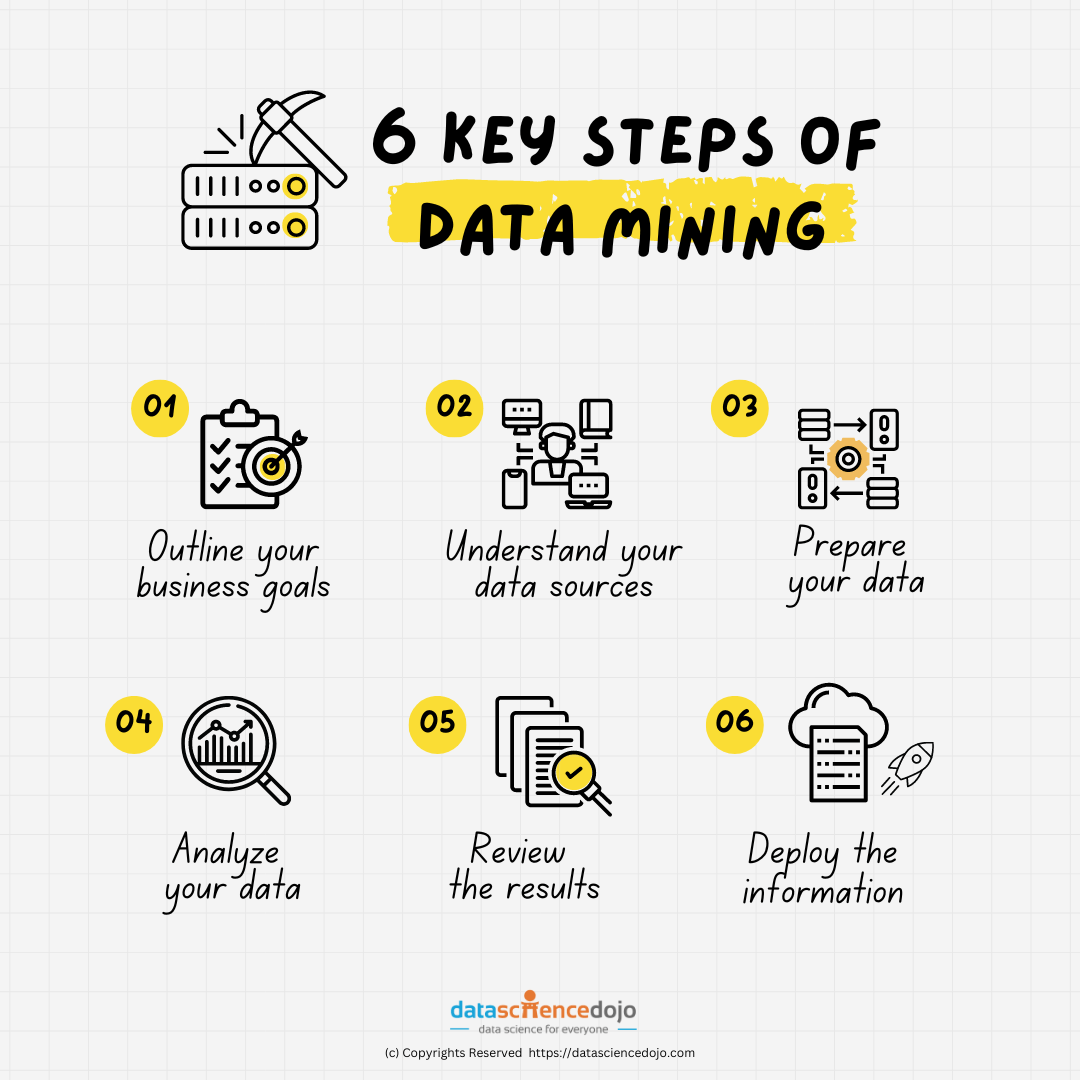In this blog, we are going to discuss data mining definition, steps, and examples. Mining sounds tedious, unfruitful, and manual. After all hacking away at rock walls for hours, hoping to find gold sounds like a lot of work. But don’t hesitate, data mining is actually quite the opposite.
With the right use of data mining, you can reap rewarding benefits without making much effort. That is because it uses modern solutions which do all the tiring jobs for us. These modern solutions are designed to sift through terabytes of data within minutes. These modern solutions provide us with valuable insights, patterns, journeys, and relationships in the data.
Read about process mining in this blog:
So, let’s dive into what data mining is and what its examples look like.
It is a type of analytical process that identifies meaningful trends and relationships in raw data. This is typically done to predict future data. Data mining tools come through large patches of data sets. They consist of a broad range of techniques to discover data structures. These techniques mainly include anomalies, patterns, journeys, or correlations.
Three data mining techniques
Data mining has been around the early 1900’s, the data mining we use today comprises three disciplines:
- The first is statistics, the numerical study of data relationships
- The second is artificial intelligence, the extreme human-like intelligence displayed by software or machines.
- Lastly, we have machine learning. The ability to automatically learn from data with minimal human assistance.
If you want to improve your learning in data mining, watch this video
Altogether, these three processes have helped us move beyond the tedious processes of the past and onto simpler and better automations for today’s complex data sets. In fact, the more complex and varied these data sets are, the more relevant and accurate their insights will be. By unveiling structures within the data, data mining yield insights that can be used by companies to:
- Anticipate and solve problems
- Plan for the future
- Make informed decisions
- Mitigate risks
- Seize new opportunities to grow
6 Steps of data mining process

The overall process of data mining generally consists of six steps:
1. Outline your business goals
It is important to understand your business objectives thoroughly. This will allow you to set the most accurate project parameters which include the period and scope of data, the primary objective of the need in question and the criteria needed to identify it as a success.
2. Understand your data sources
Understand your data sources with a deeper grasp of your project parameters. You will be able to understand which platforms and databases are necessary to solve the problem. Whether it is from your CRM or excel spreadsheets. It helps you to identify which sources best provide the relevant data needed.
3. Preparing your data
In this step, you will use the ETL process. ETL stands for Extract, Transform, and Load. This prepares the data ensuring it is collected from various selected sources, cleaned, and then collated.
4. Analyzing your data
At this stage, the organized data is fed into an advanced application and different machine learning algorithms get to work on identifying relationships and patterns that can help inform decisions and forecast future trends. This application organizes the elements of data also known as your data points and standardizes how they relate to one another.
For instance, one data model for a shoe product is composed of other elements such as color, size, method of purchase, location of purchase and buyer personality type.
5. Reviewing the results
At this step, you will be able to determine if and how well the results and insights delivered by the model can assist in confirming your predictions, answering your questions, and achieving business objectives. (“Data Mining: What It Is, How To Use It, and Why It’s Important – LinkedIn”)
6. Deployment or implementation
Once the data mining project is completed, the results are presented to the decision makers with the help of reports. Decision makers then analyze the reports and decide, how they would like to use that information to achieve their business objectives. That’s how we implement the insight to solve real-life problems.
Key benefits of data mining functionalities
Data mining offers several benefits including increased accuracy and speed, reduced costs, improved decision-making capability and flexibility, reduced human error rates and time-to-market. Data miners also have access to a wider pool of information than traditional analysts which makes them better able to identify patterns that are happening around them in their organizations’ data sets.
Read more about text mining process in this blog:
Text mining: Easy steps to convert structured to the unstructured
They can also be used for predictive analytics which aim at predicting future trends based on past events like sales volumes or customer behavior patterns – all without having to manually sift through mountains of data!
Data miners are typically used by businesses who want to improve their decision-making capabilities by using machine learning algorithms like deep learning models as well as artificial intelligence systems for machine learning algorithms (AI).
Data miners are used by businesses who want to improve their decision-making capabilities by using machine learning algorithms like deep learning models as well as artificial intelligence systems for machine learning algorithms (AI).
Is your organization using data mining?
Data mining has become more and more popular in recent years. Data mining can help companies in many ways from predicting trends to identifying new opportunities and new products. As a result, data mining has become one of the most important aspects of business today.
In fact, data mining has even been proven to be an effective way to uncover insights into complex situations such as fraud detection or credit risk management.
Learn data mining in one-hour with this crash course:


